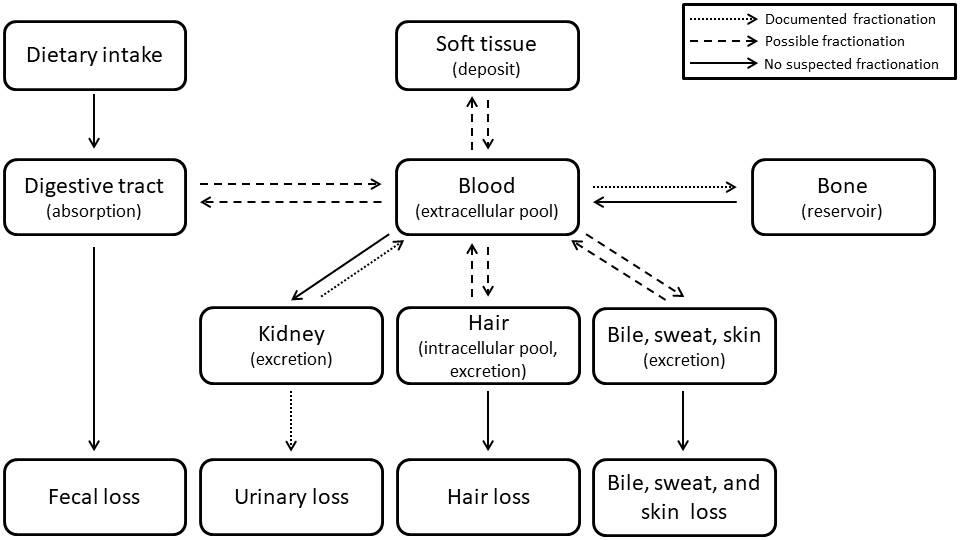Calcium Isotope Analysis and Calcium in Living Systems
Background
The study of calcium isotopic abundance variations in biological and geological systems is an extensive field of research with applications in chemical ecology, archaeology, medical biology, geochemistry, and even cosmochemistry. In particular, within the last two decades, the interest in the use of Ca isotope abundance data in biomedical research has increased significantly, and a substantial amount of the research focused mainly on the role of bone in whole body Ca homeostasis. This is because bone is made with bone-forming cells called osteoblasts, and broken down with bone-resorbing cells called osteoclasts. In the body, the bone formation (Ca deposition) and bone resorption (Ca removal) processes occur simultaneously and continuously such that mineralized Ca in bone is constantly replaced and remodeled. Ideally, in a healthy adult, the rate of bone formation and resorption should be equal, which implies the net loss (or gain) of bone mineral is zero. In addition to bone and teeth formation, calcium is also involved in muscle contraction, neural signal transmission, cell apoptosis, cell reproduction, and the coagulation of blood. Therefore, the body regulates calcium levels in the blood within a narrow range to ensure the proper function of all activities involving Ca.
The application of Ca isotopic analysis of biological samples can allow us to understand the processes that occur during Ca metabolism and bone metabolism. However, the extent of the variations of stable Ca isotope abundances in human metabolism is limited to 2 − 4 ‰ in δ (44Ca/40Ca). Therefore, sensitive and reliable methods of measuring Ca isotopic composition in the body are necessary to increase our understanding of the mechanisms that can alter or disrupt Ca metabolism.
In the biomedical field, emerging research investigating the connection between diet, gut microbiome, and nutrient absorption indicates that altering the gut microbiome can lead to enhanced calcium absorption, influencing bone health at all ages. The gastrointestinal tract serves as the initial site of calcium absorption in the body, and it hosts a diverse and abundant population of microorganisms, including bacteria, fungi, archaea, viruses, and others, collectively known as the gut microbiota that make the gut microbiome. Although the function and effects of gut microbiota are not yet fully understood, they appear to contribute to metabolic factors including, but not limited to, the digestion of food and extraction of nutrients, metabolism of drugs, modifying the host immune response and protecting against infection, and regulating the host metabolism. Imbalances in the gut microbiome due to pathogens, diseases, or disorders can negatively influence the healthy functioning of the host digestion, nutrient absorption, metabolism, immune function, etc. However, it is also possible to modify the gut microbiome through diet, and other environmental factors such as exercise or antibiotic use, to manipulate the host metabolism and other body functions.
Our Work
The research focus was to employ calcium isotope abundances in a mouse model to investigate the redistribution of calcium in the body caused by differences in gut microbiota. Since, in general, the amount of biological tissue material available was limited, only low amounts of Ca could be analyzed. The ability to accurately measure the isotopic composition of low amounts of an element in limited biological material is an essential first step to using isotope abundance measurements in clinical settings, not only for calcium, but for other metal elements as well, since lowering the amount of sample material required per test will allow for a greater number of tests to be run on a given amount of sample material. To accomplish the goal of the thesis, a measurement procedure for low-amount Ca isotope abundance measurements of biological tissue samples was developed and verified. Then a comparison was made between the Ca isotopic composition of tissues in germ-free mice, and mice that were gavaged with differing gut bacteria. Statistical tests were performed on the Ca isotopic composition of the bone tissues and kidneys for each mouse of the different gut bacteria groups to determine if there was a correlated change in the metabolism of Ca and redistribution of Ca isotopes.
Diagram of key calcium sources and deposits in mice. Figure courtesy of Dorothy Walls (MSc 2023).

